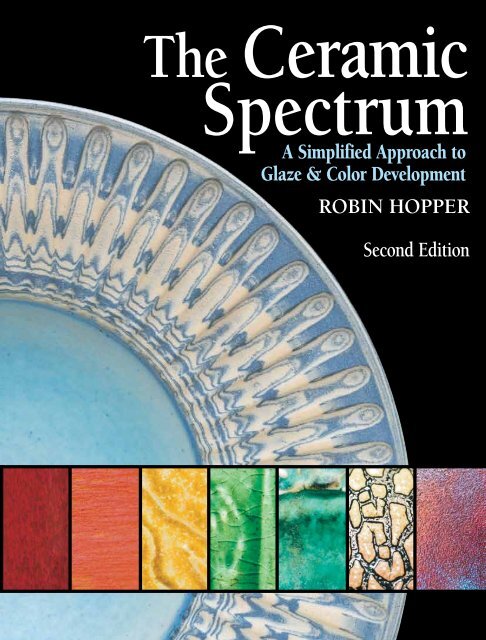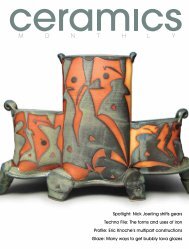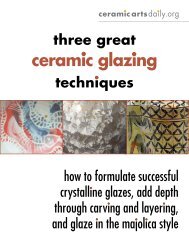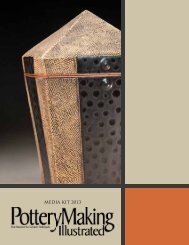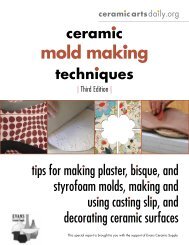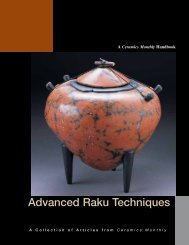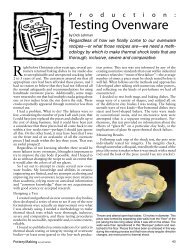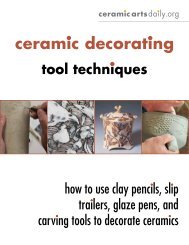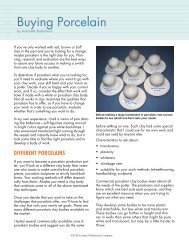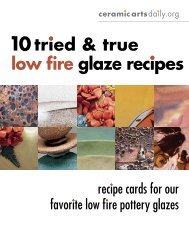Robin HoppeR - Ceramic Arts Daily
Robin HoppeR - Ceramic Arts Daily
Robin HoppeR - Ceramic Arts Daily
Create successful ePaper yourself
Turn your PDF publications into a flip-book with our unique Google optimized e-Paper software.
The <strong>Ceramic</strong><br />
Spectrum<br />
A Simplified Approach to<br />
Glaze & Color Development<br />
ROBIN HOPPER<br />
Second Edition
The<br />
<strong>Ceramic</strong><br />
Spectrum<br />
Second Edition<br />
A Simplified Approach to Glaze and Color Development<br />
<strong>Robin</strong> <strong>HoppeR</strong><br />
Published by:<br />
The American <strong>Ceramic</strong> Society<br />
600 N. Cleveland Avenue, Suite 210<br />
Westerville, Ohio 43082<br />
www.<strong>Ceramic</strong><strong>Arts</strong><strong>Daily</strong>.org<br />
3
Published by The American <strong>Ceramic</strong> Society<br />
600 N. Cleveland Ave., Suite 210<br />
Westerville, OH 43082 USA<br />
http://ceramicartsdaily.org<br />
© 1984, 2001, 2009 by <strong>Robin</strong> Hopper<br />
All rights reserved.<br />
ISBN: 978-1-57498-302-9 (Paperback)<br />
ISBN: 978-1-57498-532-0 (PDF)<br />
No part of this book may be reproduced, stored in a retrieval system or transmitted in any form or by any means,<br />
electronic, mechanical, photocopying, microfilming, recording or otherwise, without written permission from the<br />
publisher, except by a reviewer, who may quote brief passages in review.<br />
Authorization to photocopy for internal or personal use beyond the limits of Sections 107 and 108 of the U.S.<br />
Copyright Law is granted by The American <strong>Ceramic</strong> Society, provided that the appropriate fee is paid directly<br />
to the Copyright Clearance Center, Inc., 222 Rosewood Drive, Danvers, MA 01923 U.S.A., www.copyright.com.<br />
Prior to photocopying items for educational classroom use, please contact Copyright Clearance Center, Inc. This<br />
consent does not extend to copyright items for general distribution or for advertising or promotional purposes or to<br />
republishing items in whole or in part in any work in any format. Requests for special photocopying permission and<br />
reprint requests should be directed to Publisher, <strong>Ceramic</strong> Publishing Company, The American <strong>Ceramic</strong> Society, 600 N.<br />
Cleveland Ave., Suite 210, Westerville, Ohio 43082 USA.<br />
Every effort has been made to ensure that all the information in this book is accurate. Due to differing conditions,<br />
tools, and individual skills, the publisher cannot be responsible for any injuries, losses, and other damages that may<br />
result from the use of the information in this book. Final determination of the suitability of any information, procedure<br />
or product for use contemplated by any user, and the manner of that use, is the sole responsibility of the user. This<br />
book is intended for informational purposes only.<br />
The views, opinions and findings contained in this book are those of the author. The publishers, editors, reviewers<br />
and author assume no responsibility or liability for errors or any consequences arising from the use of the information<br />
contained herein. Registered names and trademarks, etc., used in this publication, even without specific indication<br />
thereof, are not to be considered unprotected by the law. Mention of trade names of commercial products does not<br />
constitute endorsement or recommendation for use by the publishers, editors or author.<br />
Publisher: Charles Spahr, Executive Director, The American <strong>Ceramic</strong> Society<br />
Art Book Program Manager: Bill Jones<br />
eBook Manager: Steve Hecker<br />
Library of Congress Catalog Number: 2001088098<br />
First edition published in 1984 under ISBN 0-8019-7275-2<br />
Second edition first published in 2001 under ISBN 0-87341-821-2<br />
4
Acknowledgments 9<br />
Introduction 10<br />
pART one: THe bASiCS 13<br />
Chapter 1 Glaze: A brief Technical History 14<br />
Chapter 2 pigeonholing: The Classification of Ware Types 36<br />
Earthenware 36<br />
Stoneware 38<br />
Bone China 38<br />
Soft Paste Porcelain 38<br />
Porcelain 38<br />
Chapter 3 Kilns, Temperature, and Atmosphere 48<br />
Electric Kilns 48<br />
Kilns Using Fossil Fuels 49<br />
Wood-Firing Kilns 49<br />
Firing, Temperature, and Atmosphere 50<br />
Reduction of Electric Kilns 50<br />
Learning to Live With a Dragon 51<br />
Basic Firing Guidelines 53<br />
pART TWo: THe DeVeLopMenT oF GLAZe 55<br />
Chapter 4 Calculation - What it Does and Doesn’t Do 56<br />
What Calculation Tells Us 59<br />
What Calculation Doesn’t Tell Us 59<br />
Selecting Materials for Glazes 59<br />
Chapter 5 Record Keeping and Testing procedures 63<br />
Recording Glaze Development 63<br />
Making Glaze Tests 64<br />
Chapter 6 basic Raw Materials in <strong>Ceramic</strong>s 67<br />
Geological Beginnings 67<br />
Clays 70<br />
Other Glaze Materials 72<br />
Testing and Using Individual Glaze Ingredients 79<br />
Chapter 7 Frits 88<br />
Fritting Materials for <strong>Ceramic</strong> Use 88<br />
Frits in Bodies and Glazes 89<br />
Comparative List of Commonly Used Frits 89<br />
Chapter 8 eutectics and Glaze Development With Two Materials 91<br />
Eutectic Material Combinations 91<br />
Two-Material Testing by the Line Blend Method 92<br />
Chapter 9 Triaxial blends 96<br />
The 21-Point Triaxial Grid 96<br />
The 66-Point Triaxial Grid 97<br />
6
Chapter 10 Quadraxial blends 101<br />
The 36-Point Quadraxial Grid 101<br />
The 121-Point Quadraxial Grid 103<br />
General Quadraxial Recommendations 106<br />
Chapter 11 Fluxes, Flux Variations, Flux Variation Triaxial, and Flux Saturations 114<br />
Alkaline or Alkaline Earths 114<br />
Lead 114<br />
Boron 115<br />
Magnesia 115<br />
Zinc 115<br />
Barium 115<br />
Strontium 115<br />
Flux Variations 115<br />
Flux Variations Triaxial 116<br />
Flux Saturation Glazes 118<br />
Chapter 12 Wood Ash and Glazes for once-Firing 119<br />
Making Wood Ash Glazes 119<br />
Using Ash as a Glaze Ingredient 120<br />
Fake or Simulated Wood Ash Glazes 121<br />
Glazes for Once-Firing 122<br />
Chapter 13 Alterations, Glaze properties, Faults, and Defects 126<br />
Glaze Alterations 126<br />
Desirable Physical Characteristics of Glazes 127<br />
Faults and Defects 128<br />
Chapter 14 Flashers 135<br />
Enamels 135<br />
Raku 136<br />
Lusters and Luster Glazes 136<br />
Aventurine Glazes 137<br />
Crystalline Glazes 138<br />
Chapter 15 oriental Style Glazes 152<br />
Iron-Colored Glazes 152<br />
Shino Glazes 154<br />
Copper Red Glazes 156<br />
Opalescence in Copper Red Glazes 158<br />
pART THRee: THe DeVeLopMenT oF CoLoR 170<br />
Chapter 16 Materials for Color Development 171<br />
Basic Colorant Materials 172<br />
Using Soluble Colorants 175<br />
Automobile and Household Paints 176<br />
Underglaze Colors, Glaze, and Body Stains 176<br />
Making Underglaze Colors and Stains 176<br />
Making Underglaze Pencils, Pastels, and Watercolors 178<br />
Serial Numbers of Glaze Bases and Color Additions Used in this Book 179<br />
7
Chapter 17 Color Testing: Mixing and blending 187<br />
Varied Color Progressions - Serial Numbers 188<br />
Color Cross-Blending 190<br />
Glaze Cross-Blending 192<br />
Chapter 18 The <strong>Ceramic</strong> Spectrum 193<br />
Specific Color Development: 46 Colors, 140 Variations 193<br />
Using Prepared Colorants - Stains 198<br />
Chapter 19 opacification 206<br />
The Characteristics of Opacifiers 206<br />
Adding Opacifiers to Glaze Recipes 207<br />
Chapter 20 Textural Variations 209<br />
Clay Additives 209<br />
Glaze Additives 210<br />
Reticulation Glazes - Highly Textured Surfaces Resembling Lichens, Lizards, and Leopards 210<br />
Metals 211<br />
Chapter 21 Color in Clays, Slips, and engobes 218<br />
Egyptian Paste 218<br />
Color in Regular Clay Types 219<br />
Mixing Colored Clays 219<br />
Color in Slips and Engobes 220<br />
Terra Sigillatas 220<br />
Engobes 222<br />
Patination 222<br />
pART FoUR: ATTACKinG THe SURFACe 233<br />
Chapter 22 Glaze Application 234<br />
Brushing 234<br />
Dipping 235<br />
Pouring 235<br />
Spraying 235<br />
Stippling 236<br />
Spattering 236<br />
Sponging 236<br />
Trailing 237<br />
Multiple Glaze Application 237<br />
Glaze Removal Processes 237<br />
Chapter 23 Conclusion 247<br />
The Development of a Personal Idiom 247<br />
Appendices<br />
Appendix 1 Table of Orton Standard Cones and Temperatures 250<br />
Appendix 2 Effective Range of Glaze Oxides 251<br />
Appendix 3 <strong>Ceramic</strong> Stains for Underglaze or Glaze Staining 252<br />
bibliography 253<br />
index 254<br />
8
1<br />
To appreciate the gradual development and<br />
understanding of ceramic materials that has<br />
occurred over at least the last 8,000 years of<br />
man’s history, it is helpful to know a little of<br />
the background that has given birth to the overwhelmingly<br />
rich and diverse art form we have in<br />
ceramics. I choose not to follow these developments<br />
in any specific chronological order, but<br />
more in the order of technological progress - the<br />
transition from pit fire to porcelain. This transition<br />
has led from the earliest accidents of pottery<br />
making to the astounding scientific advances<br />
in the use of ceramics in the space programs of<br />
the late 20th century. These advances in ceramic<br />
technology are already having a profound effect<br />
on the potter through the development of high<br />
temperature refractories such as spun kaolin<br />
insulation now used greatly in kiln construction.<br />
Further inventions will certainly create new and<br />
exciting movements for the future. The illustrations<br />
also follow the same zigzag path as ceramic<br />
history, where one culture has learned from the<br />
developments of another.<br />
Archaeologists generally agree that like most<br />
of mankind’s major discoveries, the earliest pottery<br />
probably developed by accident. This may<br />
have occurred from observations of the way<br />
the earth became baked around fire pits, with<br />
the subsequent experiment of firing clay pots.<br />
It could have also come from the accidental<br />
burning of clay-lined baskets. Baskets woven<br />
from reeds, roots, or soft tree branches were the<br />
original storage containers. At this time, man<br />
was primarily a seed-eating creature who stored<br />
his food supplies in baskets. Baskets, of course,<br />
14 The Basics<br />
Glaze: a Brief Technical hisTory<br />
are anything but impervious to the loss of small<br />
seeds, which easily find their way through the<br />
mesh of basket weave. After a while, inner coatings<br />
of clay were probably smeared onto the<br />
basket to prevent loss. The next development<br />
was likely the accidental setting on fire of one<br />
of these mud-lined baskets, resulting in the first<br />
major step in our technology - that of fired clay<br />
and thus pottery.<br />
The same sort of accident most likely<br />
occurred all over the world at different times,<br />
creating what is generally referred to as primitive<br />
pottery. Probably, because of the early associations<br />
with baskets, much of the world’s earliest<br />
pottery is decorated with simulated basket<br />
weave patterns. Over very long periods of time<br />
man developed his use for fired clay materials<br />
to encompass a wide range of functions, from<br />
seed container to sculpture, from votive doll to<br />
space capsule. In this book I am not concerned<br />
with the most recent developments of space<br />
age technology, except where pertinent to some<br />
other aspect of the potter’s art. I am concerned<br />
only with those ceramic developments which<br />
fall into the area of impervious coatings of clay,<br />
glaze, and color.<br />
When fired in a pit or bonfire, clay doesn’t<br />
get hot enough to shrink and fuse into a tight<br />
waterproof solid. Although in many cultures<br />
porous clay vessels were (and still are) used<br />
for the storage of water, where loss by evaporation<br />
caused the water to be kept cool, it soon<br />
became evident that some method for making<br />
the surface of clay impervious to water loss<br />
would be beneficial. The earliest waterproofing
was most likely done by the rubbing of pots,<br />
hot from the fire, with some form of resinous<br />
material from the leaves of trees, or by smearing<br />
the pots with animal fats to seal the pores<br />
of the clay. Burnishing the clay with a pebble<br />
also helped to develop a very smooth and fairly<br />
waterproof surface by compacting the surface.<br />
These techniques are still very much in use<br />
in societies where pottery is made in primitive<br />
ways. In fact, a significant amount of the<br />
world’s pottery is made this way, although it is<br />
falling victim to the insidious encroachment of<br />
plastics. Unfortunately, the resin- and fat-coated<br />
surfaces were not very resistant to wear with<br />
continual use, and other methods of making<br />
vessels waterproof were soon sought.<br />
The next step in the development of an impervious<br />
surface came through the use of a refined<br />
liquid clay coating, or thin colloidal slip with<br />
ultrafine particle size, which formed a glazelike<br />
skin. These slips are mostly reddish brown,<br />
dark brown, or black in color, and are generally<br />
known by the Latin name of terra sigillata,<br />
meaning sealed earth. They are made by allowing<br />
surface clays, usually red clays, to soak in a<br />
suspension of water until the heavier particles<br />
sink to the bottom. The water and thin slip are<br />
then siphoned off and the process repeated until<br />
the resultant slip is of a very fine particle size.<br />
The slip is sometimes made to liquefy and settle<br />
more readily by using an alkaline deflocculant<br />
such as lye or sodium hydroxide, sodium silicate,<br />
sodium carbonate, or even urine.<br />
The waterproof terra sigillata surface was<br />
employed by many cultures, some in very colorful<br />
ways. Despite its Latin name, its use was<br />
particularly developed by the Greeks. It formed<br />
the basic decorating medium on classical Greek<br />
pottery from very early times, and became the<br />
basis for the familiar black and red decorated<br />
ware. The black developed from the reduced slip<br />
surface (see reduction, Chapter 3) and provided<br />
the artists in the Greek society with an excellent<br />
medium in which to record their myths and customs.<br />
This pottery was fired in kilns of a more<br />
sophisticated nature than the pit-fired wares,<br />
with significant control over the firing. The<br />
subtle reduction of the surface slip was achieved<br />
without reduction of the underlying clay body.<br />
If over-reduced, both would turn black. The fact<br />
that there is still so much of this pottery around<br />
today points to a very successful methodology<br />
of firing, usually done not by the potters them-<br />
selves, but by a fireman responsible for only<br />
that part of the total process. In fact, the Greeks<br />
were the first to develop a factory system of<br />
working, where specific jobs were done by designated<br />
people. The pot was made by a potter,<br />
decorated by a painter, mainly the court painters<br />
of the time, and fired by the fireman. The<br />
degree of control each exerted in his particular<br />
field allowed interesting ceramics to develop.<br />
The forms were established along mathematically<br />
controlled lines according to the principles<br />
of the Golden Mean. The potter did not have<br />
much opportunity for self-expression; the vessel<br />
was just the ground for the more important<br />
painting on the surface. Although we often find<br />
that the pot and surface tend to detract from<br />
each other, in the hands of sensitive painters,<br />
the integration of form and surface is delightful.<br />
Scenes of mythological heroics and histrionics<br />
abound on the vast majority of these pots,<br />
done with a combination of brush painting,<br />
sgraffito (scratching through the painted surface<br />
with a pointed metal implement of some sort),<br />
and sometimes post-firing additions of white<br />
details. This seemingly small palette of color<br />
was entirely sufficient to depict the subject matter<br />
for these wares.<br />
Terra sigillata was also used to a very large<br />
degree by the Romans for the pottery made<br />
especially for the patricians, and was known as<br />
Samian or Arretine ware. Instead of being painted,<br />
however, this ware was generally made in<br />
molds where a decoration was cut into the mold<br />
surface. Clay was then pressed into the mold,<br />
forming a raised relief pattern. These wares emulated<br />
the raised repoussé decoration of silver and<br />
gold vessels that possibly originated in China.<br />
Decoration was also made by painting with a<br />
fairly stiff slip, sometimes referred to as paté<br />
sur paté or barbotine, to leave a similar raised<br />
surface. The piece was subsequently dipped into<br />
a thin sigillata slip and fired in a kiln with no<br />
reduction, leaving a reddish satin surface. Roman<br />
pottery decoration rarely has the same vigor as<br />
that of the earlier Greek wares, and far less is<br />
seen in the museums of the world. Many other<br />
cultures used terra sigillata techniques for sealing<br />
and beautifying the surfaces of their wares, particularly<br />
pre-Colombian cultures of Central and<br />
South America. Terra sigillata slips have been in<br />
use for thousands of years.<br />
The first actual glazed surface most likely<br />
occurred, again probably accidentally, in the area<br />
Glaze: A Brief Technical History 15
of Egypt or Syria approximately 5,000 years<br />
ago. The usual theory of the first glaze development<br />
comes from the probable use of sandstone<br />
containing considerable sodium and potassium,<br />
called natron, as the material with which to build<br />
a fireplace. Natron has a very low melting point<br />
and the surface of the rock facing the fire would<br />
easily develop to a fused glaze. A fairly logical<br />
step from this point might have been to make<br />
small statues from this sandstone and heat them,<br />
and this is what most likely led to the first glaze<br />
on pottery. Natron, sand, and clay were mixed,<br />
and figurines were made by pressing the mixture<br />
into molds. When the material dried, the soluble<br />
sodium materials migrated to the surface, forming<br />
a powdery scum. When heated to a low red<br />
heat, this scum melted, and combined with the<br />
clay to form a glaze. This is, in fact, a self-glazing<br />
clay, which we now call Egyptian paste. It<br />
was often colored by the introduction, natural<br />
or fabricated, of metallic compounds of copper,<br />
manganese, iron, and cobalt.<br />
Although it may have taken several hundred<br />
years to happen, technically it is a comparatively<br />
small jump from this material to a glaze made<br />
from the same materials, put into a solution with<br />
water, and subsequently used to coat the pottery<br />
form. So we have the first glazes developed<br />
for use on pottery. This discovery seems to have<br />
had little practical use in functional pottery for<br />
quite some time. Egyptian patricians generally<br />
used either gold or alabaster for their functional<br />
needs, and the humble peasant potter made use<br />
of simple unglazed dishes and storage containers<br />
for his daily life, blissfully unaware of the<br />
fact that he could have had impermeable glazed<br />
surfaces to eat from and store liquids in. Alkaline<br />
glazes such as these had certain drawbacks, such<br />
as some solubility after firing, particularly when<br />
used in cooking. There were also difficulties in<br />
application, as well as a strong tendency to craze<br />
and chip easily. However, even with their drawbacks,<br />
they were a great deal more serviceable<br />
than the earlier unglazed wares.<br />
Further developments were needed, and the<br />
next important advance in the understanding<br />
of materials came with the introduction of lead<br />
compounds into materials for use by potters.<br />
Lead compounds were fairly common, and it was<br />
found that lead sulfide, or galena, when ground<br />
up and applied to the surface of the clay, would<br />
easily melt and fuse to a shiny smooth glaze. This<br />
advance probably occurred in either Babylonia<br />
16 The Basics<br />
or Syria between 3000 and 2500 B.C. Both lead<br />
and alkaline materials were used together in the<br />
production of colored glazes.<br />
At this point I should make it clear that neither<br />
alkalis nor lead are glazes in themselves, but<br />
become so because of the immediate availability<br />
of silica and alumina in clay when combined.<br />
A period of ceramic history where the simplest<br />
use of lead is apparent is in the pottery of<br />
medieval England. Damp pots were dusted with<br />
powdered galena, which, when the pots dried<br />
and were fired, fused with the clay to form a<br />
glazed surface.<br />
We now know that these wares were potentially<br />
hazardous, but for several centuries simple<br />
lead glazes were used for the production of<br />
amber, colored, and clear glazes for domestic<br />
pottery. Today, in many parts of the world and in<br />
many countries, the use of lead is either banned<br />
outright or severely restricted. Although the use<br />
is diminishing, simple lead glazes are still used<br />
in many areas, presumably because of availability<br />
and ease of fusion.<br />
The Assyrians learned to make colored glazes<br />
by the addition of metallic oxides to the lead<br />
glaze, and with these glazes decorated huge<br />
architectural edifices with multicolored low relief<br />
bricks and tiles. This represented a high development<br />
in the process of glaze making.<br />
Knowledge of the use of lead in glazes spread<br />
eventually to China, and much of the pottery<br />
of the Han dynasty (25-220 A.D.) used lead for<br />
its surface. In many cultures, clay was used as a<br />
material to provide an acceptable copy of other<br />
more precious materials, and both the form and<br />
surface of much Han dynasty pottery emulated<br />
bronze. The addition of copper to lead glazes<br />
produced colors that closely resembled bronze.<br />
Lead glazes later developed into regular use for<br />
pottery, and eventually to a wide range of colored<br />
glazes.<br />
Low-temperature earthenware glazes fulfilled<br />
the needs of mankind for many centuries before<br />
the next major step in glaze technology occurred.<br />
This step depended on the development of a<br />
kiln that could fire at considerably higher temperatures<br />
than previously possible. With the<br />
discovery of more heat-resistant clay materials<br />
that could be used for kiln building, the production<br />
of a dense, hard form of pottery, which we<br />
call stoneware, became possible. Stoneware clays<br />
had very great advantages over the red-burning<br />
low-temperature clays in use at the time; when
fired, they were considerably harder, and thus<br />
more durable.<br />
These new developments in ceramic technology<br />
occurred in China as long ago as 1500 B.C.,<br />
and represented a great technical leap forward.<br />
With higher temperatures, new forms of glaze<br />
were needed. The earliest to appear were those<br />
that came from the natural melting of wood ash,<br />
as it moved through the kiln from the stoking of<br />
the fireboxes, and of the red-burning clays which<br />
fused to brown or black glass.<br />
Wood ash is a material which, at high temperatures,<br />
fuses with the clay and forms glazed<br />
surfaces with no other materials needed. Another<br />
common material that formed the basis of hightemperature<br />
glazes with no other additions was<br />
the red earthenware clay which had until this<br />
point been the basic material for the production<br />
of the pots themselves. These clays contained the<br />
basic requirements of flux, alumina, and glassformer,<br />
to form a glaze. When liquefied to slip<br />
and applied over the stoneware clay, they turned<br />
readily into a gloss surface when exposed to a<br />
sufficiently hot fire. Combinations of wood ash<br />
and clay in varying ratios were used to make a<br />
wide variety of glazes.<br />
With the further understanding of their raw<br />
materials, the potters toiled for more refinement,<br />
and through the use of rocks ground to powder<br />
learned to produce a wide range of glazes at high<br />
temperatures. The powdering of a certain igneous<br />
rock called petuntze, and the subsequent<br />
intermixing with a light firing clay called kaolin<br />
brought about the development of what was to<br />
become the most sought after pottery compound<br />
ever produced - porcelain.<br />
Although quite refined, white-firing clays for<br />
pottery making date back to about 1500 B.C., the<br />
Chinese first produced porcelain during the Tang<br />
dynasty (618-906 A.D.) from the refinements of<br />
hard-firing light-colored stoneware clays used<br />
in the Han dynasty. These gradual refinements<br />
produced a paste material which, when fired<br />
properly, had a quality of translucency never seen<br />
before. The refinements reached their peak during<br />
the Song dynasty (960-1220 A.D.), although<br />
further developments were made in later dynasties.<br />
The new material was more or less half clay<br />
and half glass, and retained some of the qualities<br />
of both materials. Not only was it translucent, it<br />
also rang like a bell when tapped. It was so close<br />
to glass in its makeup that when glazes were<br />
developed for its surface, the materials fused<br />
together so completely that the body and its skin<br />
were integrated as never before. The resultant<br />
material was so pure and fine that the Venetian<br />
merchant explorer Marco Polo dubbed it “porcellana”<br />
after the quality of the smooth glossy<br />
seashell.<br />
The development of this wonderful new<br />
material represented the ultimate achievement<br />
of the potter’s art. The subsequent export of<br />
wares made from porcelain across the Asian<br />
trade routes, and later in large volume by ship,<br />
brought about great changes in pottery styles in<br />
the areas it touched.<br />
The world of Islam was the first to experience<br />
this change. Pottery production in the Islamic cities<br />
on the trade routes was at this time limited to<br />
earthenware. The new imports from China were<br />
highly prized and sought after. The net effect of<br />
this trade was to put the livelihood of the local<br />
potter in jeopardy, who had neither the raw<br />
material resources nor the expertise to produce<br />
porcelain. In reaction he produced copies of the<br />
refined Chinese wares, using the materials he was<br />
familiar with. The addition of tin oxide to the<br />
lead and alkaline glazes created an opaque white<br />
base for added decoration. He also often used a<br />
white slip under the glaze to further whiten the<br />
ware, in the hope of competing with the imports.<br />
To the untrained eye, the copy and the original<br />
are very easily confused.<br />
The same development of copies occurred in<br />
the port cities such as Delft in Holland, Bristol<br />
and Lowestoft in England, and many other<br />
European ports, as well as others in various<br />
parts of the world at a considerably later date.<br />
However, the hunt was on for the secret of the<br />
wondrous material in centers of pottery making<br />
all over Europe, and this in itself led to other<br />
technical developments. The secret was eventually<br />
found in Germany in the 18th century, but the<br />
search had already led to the invention of both<br />
soft-paste porcelain and bone china. Since glaze<br />
chemistry at this time was purely an empirical<br />
affair, the developments were slow in coming.<br />
This is not surprising, particularly when you<br />
remember that the secrets were passed through<br />
generations of families, and little change might<br />
occur in a single lifetime.<br />
Islam saw the growth of many different styles<br />
of pottery within its borders, particularly of<br />
surface embellishment using the wide range of<br />
color available with low-temperature glazes. Two<br />
processes of decorating on top of an already<br />
Glaze: A Brief Technical History 17
fired glaze were used. The first, smoked luster,<br />
was made by fusing a thin layer of metal to the<br />
slightly softened glaze surface by heavy reduction<br />
of metallic salts, creating an iridescent sheen. The<br />
second, using a highly colored, very low-temperature<br />
glaze led to what we call overglaze enamel.<br />
Wares from Islam traveled across the trade routes<br />
to China and soon the decorative use of enamels<br />
was seen in great abundance, although they may<br />
well have been independently developed there.<br />
The new Chinese wares were exported in great<br />
volume to the Middle East, to Europe, and to<br />
Japan in the 17th and 18th centuries. This led to<br />
the production on a massive scale of wares of an<br />
oriental flavor in factories throughout Europe,<br />
and was itself responsible for the great surge of<br />
growth of industrially produced wares of the<br />
18th and 19th centuries. The cycles of growth,<br />
alteration, refinement, and further growth continue<br />
to the present day.<br />
One particular development that seems to<br />
have no associations with other cultures was<br />
that of salt glaze, which occurred in Germany<br />
during the 15th and 16th centuries. This seemingly<br />
autonomous discovery of the reaction that<br />
takes place when salt is thrown into the very<br />
hot kiln brought an interesting new surface to<br />
pottery. The salt volatilizes in the kiln, and fills<br />
the interior with fumes. The sodium gases react<br />
with the silica of the clay to form a glassy, often<br />
textured surface. Its use was initially restricted to<br />
the Germanic countries, and its often dull grey<br />
or brown color did little to increase its universal<br />
18 The Basics<br />
appeal. Except for small isolated areas in England<br />
and France, its use remained very much a localized<br />
tradition until the emigration of German<br />
potters who brought the technique to the east of<br />
North America in the early 19th century, where it<br />
saw renewed growth.<br />
By the end of the 17th century, the growth<br />
and development of all the major technical<br />
advances in pottery had occurred, and in many<br />
cases, their rise and subsequent demise as fashion<br />
dictated. The only real developments left<br />
were those attempts to place our long empirical<br />
history into a scientific context. The German<br />
chemist Dr. Hermann Seger developed the scientific<br />
approach to glaze calculation with the<br />
invention of the Seger Formula in the late 19th<br />
century. This comparative system, generally used<br />
by industry, facilitates easy comparison between<br />
various formulae of glazes for ceramics. Seger<br />
was also responsible for the invention of ceramic<br />
cones to enable more accurate control of the<br />
firing process. The rise of industrialization, and<br />
with it, standardization, has had the unfortunate<br />
side effect of eliminating much of the personality<br />
of most of the world’s pottery in the process.<br />
The ceramic industry continues to improve<br />
its products, and the 20th century has seen great<br />
advances in many sectors. The development of<br />
new and more stable colorants and the invention<br />
of various materials to solve the problems of<br />
space travel have given the 20th century ceramist<br />
new materials and directions to explore. It is an<br />
exciting time.
1.1. Spouted Jug, Cyprus, 1850-1700 B.C. Earthenware with<br />
pink-buff fine grained clay, decorated with a lustrous dark red slip<br />
and white-filled incised lines. M1.36. The Sid Leary Memorial<br />
Collection. Courtesy of the UBC Museum of Anthropology,<br />
Canada. Photo by Janet Dwyer.<br />
1.2. Tankard, Cyprus, 1550-1400 B.C. Dark redbrown<br />
earthenware clay with white slip and thin<br />
painted iron decoration. M1.31. The Sid Leary<br />
Memorial Collection. Courtesy of the UBC Museum<br />
of Anthropology, Canada. Photo by Janet Dwyer.<br />
Glaze: A Brief Technical History 19
1.4. Miniature Jug, Cyprus. Mottled red and black clay, full<br />
of white limestone particles. Splayed foot, globular body, tall<br />
narrow neck, trumpet mouth, flat strap handle from rings on<br />
neck and shoulder. M1.24. Courtesy of the UBC Museum of<br />
Anthropology, Canada. Photo by Janet Dwyer.<br />
20 The Basics<br />
1.3. Footed Krater, Greece, 730-700 B.C. Buff-colored<br />
earthenware with modified geometric design<br />
painted in iron. Ce226. The Carol and James<br />
George Collection. Courtesy of the UBC Museum of<br />
Anthropology, Canada. Photo by Janet Dwyer.
1.5. Black Figure Hydria (water jug), Greek, Attic, c. active about 525-500 B.C. Dionysus and Two Satyrs,<br />
pottery, incised and painted decoration, unknown artist close to the Nikoxenes Painter, 1939.Cb.1. Courtesy of<br />
the Montreal Museum of Fine <strong>Arts</strong>, Gift of Harry A. Norton.<br />
Glaze: A Brief Technical History 21
1.7. Vessel with face,<br />
Tiahuanaco/Huari, c. A.D.<br />
800-1000, Mexico. Burnished<br />
earthenware with painted<br />
and modeled decoration.<br />
G83.1.318. Courtesy of the<br />
Gardiner Museum Collection,<br />
Toronto, Canada.<br />
22 The Basics<br />
1.6. Standing figure, Colima, Proto Classic,<br />
West Mexico, c. 100 B.C.-250 A.D. Burnished,<br />
modeled and painted earthenware. Courtesy of<br />
the Gardiner Museum of <strong>Ceramic</strong> Art, Toronto,<br />
Canada.
1.8. Cylindrical earthenware vessel with<br />
painted decoration, Maya, Late Classic,<br />
c. A.D. 550-950, Mexico. G83.1.109.<br />
Courtesy of the Gardiner Museum<br />
Collection, Toronto, Canada.<br />
1.9. Four-footed, burnished and painted<br />
earthenware vessel, Maya, Early Classic,<br />
c. A.D. 250-550, Mexico. G83.1.138.<br />
Courtesy of the Gardiner Museum<br />
Collection, Toronto, Canada.<br />
Glaze: A Brief Technical History 23
1.10. Olla-Acoma Pueblo, New Mexico, 19th century. Buff-colored clay with geometric, “floral-like” polychrome<br />
(black and brown) design on white slip. The Ruth Jones Collection. Courtesy of the UBC Museum of Anthropology,<br />
Canada. Photo by Janet Dwyer.<br />
24 The Basics


